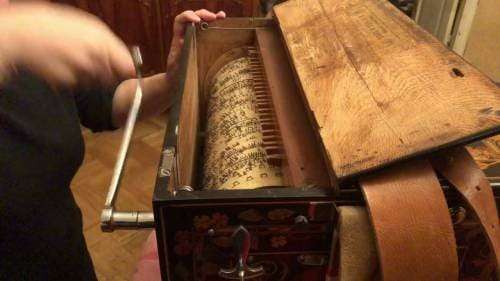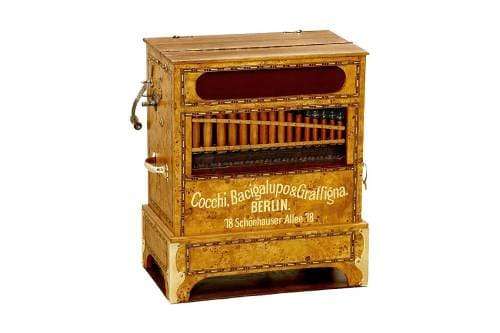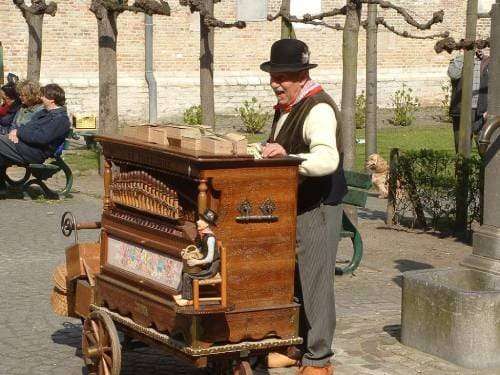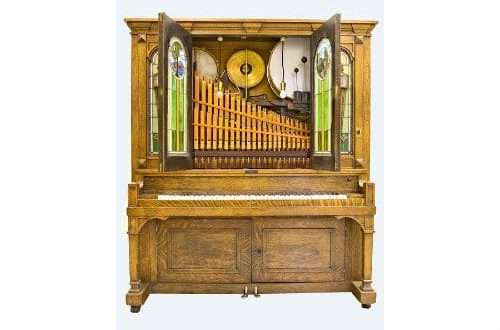
Barrel organ: instrument composition, principle of operation, history of origin
In the XNUMXth century, itinerant musicians entertained onlookers in the streets with unpretentious melodies produced by a hand-held musical instrument called a street organ. The small mechanical device seemed to be an amazing, magical creation. The organ grinder slowly turned the handle of the box, a melody poured out of it, the sound of which fascinated adults and children.
Structure and principle of operation
The first designs were quite simple. A roller with pins was installed inside the wooden box, it was spinning, the pins captured the “tails” corresponding to a certain sound. This is how simple music was played. Soon there were barrel-organs with a xylophone mechanism, when the pins act on certain keys. Such designs were more overall, it was difficult to wear them.

Despite the seeming simplicity for the beginning of the 18th century, the barrel organ has a rather complex mechanism and is a small organ without keys. The tool works by supplying air to the bellows. First, by rotating a special handle, air is pumped, and then sound extraction begins. Rotating the handle of the roller, the organ grinder sets the levers in motion. They act on the reeds that open and close the air valves. Small pipes are placed inside, reminiscent of organ pipes, and the air entering them, the length of the flow of which is controlled by valves, creates sound.
Initially, the hurdy-gurdy “gave out” one melody, but after improvements it could already play 6-8 pieces. The increase in the number of melodies occurred due to the change of the roller with hairpins.
At the beginning of the XNUMXth century, hurdy-gurdy appeared, in which the rollers were replaced by perforated ribbons with holes arranged in a special order corresponding to the score. The device received a reed mechanism, and due to the injection of air that passed through the holes, trembling, intermittent sounds appeared. The same device was used in pianolas.

The history of the origin of the barrel organ
For the first time, such a principle of sound extraction appeared in the XNUMXst century BC. Even then, ancient people learned to use rollers with small protrusions, each of which was responsible for a specific note.
The street organ in the form in which most people know it appeared in the XNUMXth century in Europe. It could have been invented even earlier in medieval Holland, where only drawings of the mechanism have been preserved. But they are too old to disassemble the device in detail, so the Dutch origin has not been proven. It is believed that the design was originally used to tame birds, which is why it was called “drozdovka” or “chizhovka”.
And yet, France is considered the birthplace of the barrel organ. It was along the streets of French cities that wandering musicians walked with a portable box that played the popular melody “Charmante Catherine”. The creation of a mechanical device for playing music is attributed to the Italian master Barbieri and the Swiss Antoine Favre. And the German way of life entered the instrument as “Drehorgel” – “revolving organ” or “Leierkasten” – “lyre in a box”.

In Russia, the sound of the barrel organ became familiar in the 19th century. She was called “Katerinka” by the name of the heroine of the first song. It was brought by Polish wandering musicians. Instrument sizes ranged from small boxes that could be easily carried around to cupboard-sized structures. By that time, the characteristics of the device were already more advanced, by changing the perforated tapes it was possible to play different melodies.
The barrel organ has become a real work of art. Tools appeared, inlaid with carvings, decorated with stones and ornaments. Often organ grinders performed together with puppeteers, staging small performances on the streets.
Interestingly, the profession of an organ grinder has not died even today. On the squares of German cities, you can meet an elderly man with a hurdy-gurdy on a cart, entertaining the public and tourists. And in Denmark, it is customary to invite an organ grinder to a wedding to give the celebration a special flavor. If it is not possible to invite a musician, then you can always meet him on the Charles Bridge. In Australia, people hold parades to mechanical music. The old hurdy-gurdy also sounds on other continents of the planet.




